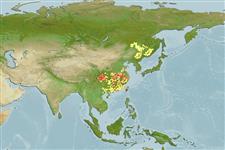Actinopterigi (pesci con pinne raggiate) >
Cypriniformes (Carps) >
Cyprinidae (Minnows or carps) > Xenocyprinae
Etymology: Hypophthalmichthys: Greek, hypo = under + Greek, ophthalmos = eye + Greek, ichthys = fish (Ref. 45335); molitrix: molitrix, approximately grinder (referring to the pharyngeal grinding apparatus) (Ref. 10294).
Ambiente / Clima / Range
Ecologia
; acqua dolce benthopelagico; potamodromo (Ref. 51243); distribuzione batimetrica 0 - 20 m (Ref. 6898). Subtropical; 6°C - 28°C (Ref. 37797), preferred ?; 64°N - 43°S
Asia: Native to most major Pacific dainages of East Asia from Amur to Xi Jiang, China (Ref. 59043). China and Eastern Siberia. Introduced around the world for aquaculture and control of algal blooms. Several countries report adverse ecological impact after introduction (Ref. 1739). Often confused with Hypophthalmichthys nobilis (Ref. 59043).
Length at first maturity / Size / Peso / Age
Maturity: Lm 51.7 range ? - ? cm
Max length : 105 cm TL maschio/sesso non determinato; (Ref. 40637); common length : 18.0 cm SL maschio/sesso non determinato; (Ref. 35840); Peso massimo pubblicato: 50.0 kg (Ref. 30578)
Spine dorsali (totale): 1 - 3; Raggi dorsali molli (totale): 6-7; Spine anali 1-3; Raggi anali molli: 10 - 14. Body olivaceous to silvery. Barbels absent. Keels extend from isthmus to anus. Edge of last simple dorsal ray not serrated. Branched anal rays 12-13.5 (Ref. 13274). Differs from Hypophthalmichthys nobilis by having sharp scaleless keel from pectoral region to anal origin, 650-820 long, slender gill rakers, head length 24-29% SL, and plain pale coloration, greenish grey above, whitish below (Ref. 59043).
Found in their natural range in rivers with marked water-level fluctuations and overwinters in middle and lower stretches, swimming just beneath the surface. They feed in shallow (0.5-1.0 m deep) and warm (over 21°C) backwaters, lakes and flooded areas with slow current on phytoplankton and zooplankton (Ref. 30578, 10294). Bigger individuals from about 1.5 cm SL feed only on phytoplankton while larvae and small juveniles prey on zooplankton (Ref. 59043). Adults breed in rivers or tributaries over shallow rapids with gravel or sand bottom, in upper water layer or even at surface during floods when the water level increases by 50-120 cm above normal level. Conditions for spawning include high current (0.5-1.7 m/s), turbid water, temperatures above 15°C (usually 18-26°C) and high oxygen concentrations (Ref. 59043). Spawning ceases if conditions change (especially sensitive to water-level fall) and resumes again when water level increases. Juveniles and adults form large schools during spawning season. Mature individuals undertake long distance upriver migration at start of a rapid flood and water-level increase, able to leap over obstacles up to 1 m. After spawning, adults migrate to foraging habitats, In autumn, adults move to deeper places in main course of river where they remain without feeding. Larvae drift downstream and settle in floodplain lakes, shallow shores and backwaters with little or no current (Ref. 59043). In aquaculture, it can survive brackish water (up to 7 ppt) when released into estuaries and coastal lakes (Ref. 59043). Escape from fish farms are widely known even as they are stocked in large rivers and almost all still water bodies like lakes and ponds. Utilized fresh for human consumption and also introduced to many countries where its ability to clean reservoirs and other waters of clogging algae is appreciated even more than its food value (Ref. 9987). One of among 3 or 4 species of cyprinids whose world production in aquaculture exceeds 1 million tons per year (Ref. 30578).
Skelton, P.H., 1993. A complete guide to the freshwater fishes of southern Africa. Southern Book Publishers. 388 p. (Ref. 7248)
IUCN Red List Status (Ref. 115185)
CITES (Ref. 94142)
Not Evaluated
Threat to humans
Potential pest
Human uses
Pesca: commerciale; Acquacoltura: commerciale
Strumenti
Special reports
Download XML
Fonti Internet
